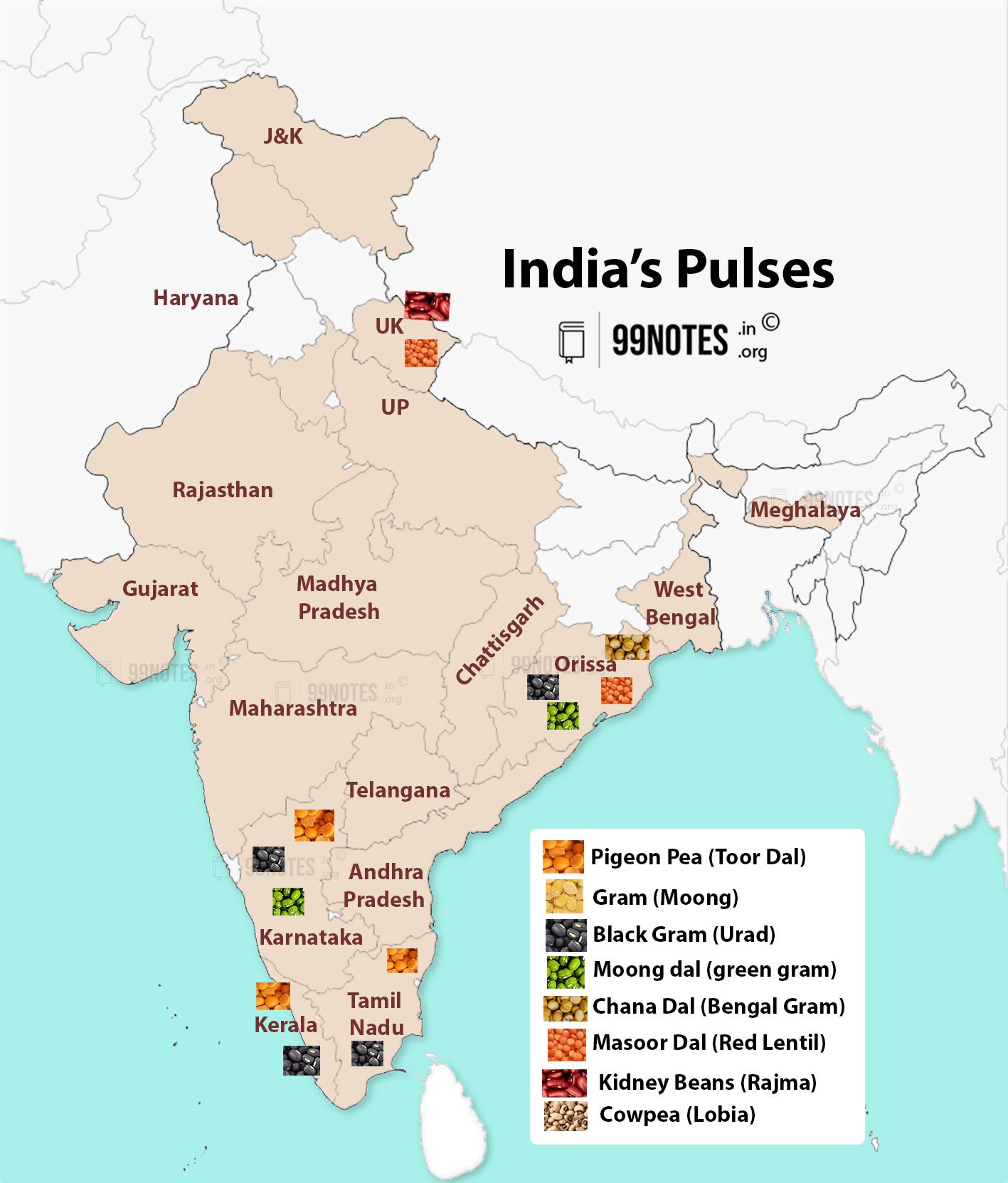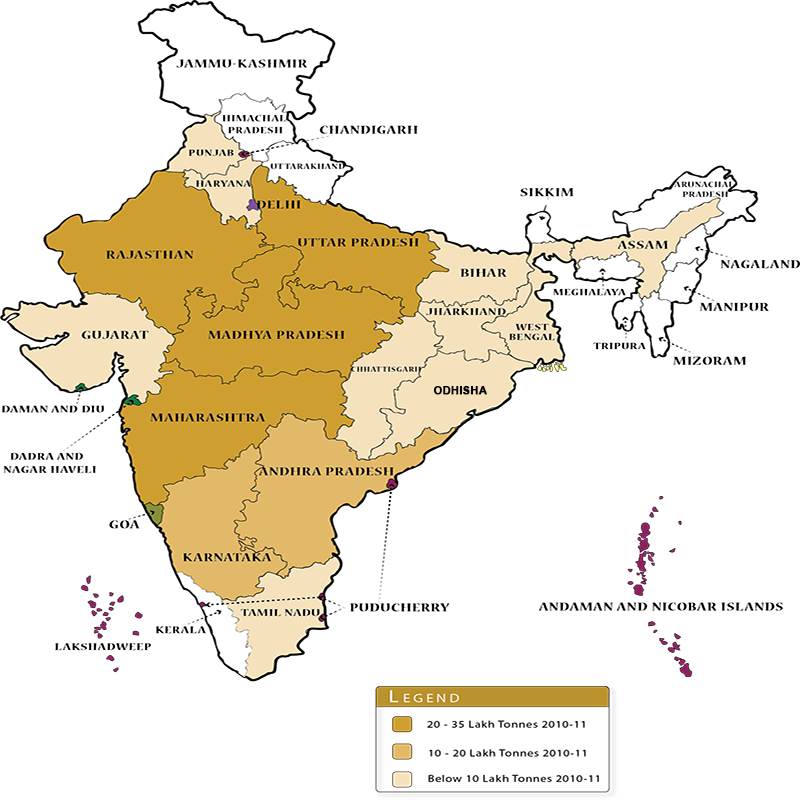Pulses

Therefore, the term pulses refers to leguminous crops except:
- Green beans and green peas are considered vegetables.
- Oilseeds like Soybeans and peanuts, and
- Seeds that are exclusively used for forage such as clovers and alfalfa.
Importance of Legumes
- Legume crops increase the natural fertility of soils. Many legumes contain symbiotic bacteria called Rhizobia within root nodules. These bacteria have the ability to break molecular nitrogen and create ammonia using water. This is called Nitrogen fixation. The plants release excess amino acids into the soil increasing soil fertility.
N2 -> NH4+ -> Amino Acids -> Proteins
When practised with inter-cropping, agriculture becomes highly sustainable.
- Due to nitrogen fixation, pulses are packed with proteins. In fact, these are the only source of protein for most of the Indians.
- Import Substitution and Export Potential: India is a leading producer and it has a large export potential. However, currently, we are import-dependent to fulfil our protein needs through pulses.
Other Advantages of growing pulses:
- Easy to grow: It can easily be produced in dryland and rainfed areas, making it suitable for emerging climatic challenges.
- Diverse usage: Used as both food and forage.
- Easy to store post-harvest – there is a possibility of creation of buffer stock.
Production of Pulses in India
India has always been the most important grower of pulses, due to its dietary habits.
- India’s total Production: 25MT in 2021 which is about 1/5th of the total production of the world.
- It is largely concentrated in dry lands of Deccan and central plateaus and North-Western parts – 11% of total production. Yields are low and fluctuate being a rainfed crop.
However, in recent times our import dependence has increased as the farmers have shifted towards the production of cereals.
|
Crop |
Conditions | States in India |
India’s Position |
| Gram (Chana)
Most important Pulse |
Grown in Subtropical areas:
|
MP, UP, Maharashtra, Andhra and Rajasthan Before the Green Revolution: Punjab and Rajasthan were the largest, which have now shifted to rice and wheat. Yield continues to be low and fluctuates – can be increased with irrigation. |
2.8% of the total cropped area |
| Tur: Arhar, red gram or pigeon pea – 2nd most important |
|
Maharashtra contributes 1/3rd. Other states: UP, Karnataka, Gujarat and MP. Per hectare output – yield is very low. |
2% of cropped area. |
| Moong |
|
Diverse Area: Maharashtra, Rajasthan, Karnataka, Andhra Pradesh, Madhya Pradesh, Uttar Pradesh, and Tamil Nadu. The average yield in India varies between 800-1200 kg/ha. |
|
| Urad |
|
Diverse Areas: UP, Maharashtra, Andhra Pradesh, Telangana, Karnataka, and MP. With irrigation: Grown in South India and Gujarat in winters Average yield varies between 700-1000 kg/ha. |
|
| Masur |
|
|
|
| Peas |
|
|
Seasons:
- Rabi crops require a mild cold climate during the sowing period, during vegetative to pod development cold climate and during maturity / harvesting warm climate.
- Kharif pulse crops require a warm climate throughout their life from sowing to harvesting.
- Summer pulses are habitants of warm climates.
- Seed is required to pass many stages to produce seed like germination, seedling, vegetative, flowering, fruit setting, pod development and grain maturity/harvesting.
Concerns:
- Import Dependency: The production of pulses in the country increased from 11 million tonnes in 2002-03 to 3 million tonnes in 2013-14. However, imports also grew in this period, from 0.06 million tonnes in 2000-01 to 5.53 million tonnes in 2015-16.
- Unstable yield in India: The lower productivity of pulses is attributed to
- A paradigm shift in the area under cultivation of traditional crops to cash crops,
- The crop is susceptible to pests and diseases
- Poor crop management practices like low fertilizer use
- Poor innovation in Seed: non-availability of high-yielding and good quality seed to the farmers
- Government Subsidy Regime favours rice, wheat and sugarcane.
- Storage facilities – Not enough silos for pulses.
- The procurement infrastructure under APMC Mandis is not adequate.
- Short-term actions: The government allows import when the price is high which negatively affects the Pulses farmers.
| Arvind Subramaniam Committee Report |
| On account of the volatility of the prices of pulses, a committee on “Incentivising Pulses Production through MSP and related policies” was set up under the chairmanship of Dr Arvind Subramanian, CEA which submitted its report in 2016.
Conclusion of this report on pulses:
Recommendations:
Institutional arrangement for pulses:
|
Government Steps:
- Higher MSP: Currently, the government gives MSP on 5 pulses (chana, arhar, moong, urad and masur). For Arhar it is currently ₹7,000/quintal, for Moong, it is ₹8,682. For all the pulses it has increased by more than 50% compared to 2015-16.
- 2017 had been declared as the National Year of Pulses to signify the increased focus on Pulses.
- Increased Buffer Stock: A buffer stock of 2 million tonnes was sanctioned in 2016, or about 10% of the country’s production. Currently, the buffer stock is at 43.82 Lakh Crore.
Development in Seeds
Subramanian Committee report on pulses, submitted to the ministers of finance, agriculture and consumer affairs, the possibilities created by a new variety of arhar (pigeon pea).
Pusa Arhar16
- It has a yield greater than existing varieties of Arhar (about 2000 kg/hectare),
- Why? Because: The size of the pea is uniform, making it amenable to mechanical harvesting, an attractive feature for farmers in northern India who currently use this technology for paddy.
- Less Pollution: Most important, arhar straw, unlike paddy straw, is green and can be ploughed back into the soil.
- In paddy straw, the problem is the high silica content, which does not allow for easy decomposition. Farmers, therefore, choose the easiest option of simply burning it.
Can be a game changer in paddy-growing regions of Punjab, Haryana and UP?
FAQs related to Pulses








